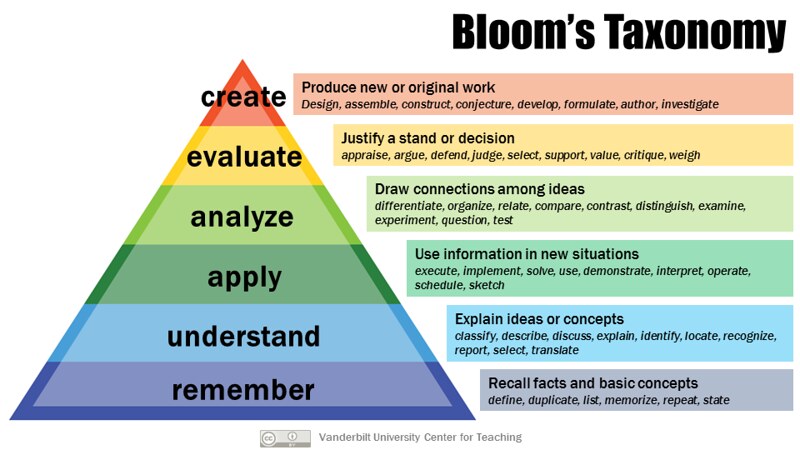Selecting an action verb using Bloom's Revised Taxonomy (2001)
Overview
Action verbs within the structure of learning objectives can be selected using taxonomies.
In 1956, Benjamin Bloom collaborated with Max Englehart, Edward Furst, Walter Hill, and David Krathwohl to publish a framework of taxonomies for categorizing the educational goals of three learning domains:
- cognitive (knowledge or thinking)
- affective (feelings or emotions), and
- psychomotor (manual or physical skills)
titled Taxonomy of Educational Objectives: The Classification of Educational Goals. The cognitive domain taxonomy has been a primary focus in education and is commonly known as Bloom's Taxonomy. Bloom's original cognitive domain taxonomy consisted of six major categories (nouns) with correlating action verbs presented as a spectrum of lower-order thinking skills (LOTS) to higher-order thinking skills (HOTS):
- Knowledge, Comprehension, Application, Analysis, Synthesis, and Evaluation
In 2001, Anderson and Krathwohl revised the original Bloom's Taxonomy by replacing the major category nouns with the action verbs and gerunds:
- Remember, Understand, Apply, Analyze, Evaluate, and Create
Bloom's Revised Taxonomy (2001) is the version of Bloom's Taxonomy widely used in education today.

Supplemental resources
The Bloom's Taxonomy Verbs PDF provided by Future Focused Learning provides action verbs for each category of the cognitive domain taxonomy. Some of the words in this list are action verbs not typically included in the more traditional listings.
The Learning Objectives Wheel Webpage by Stony Brook University Center for Excellence in Learning and Teaching (CELT) offers an interactive wheel where the darkest blue indicates the category, medium blue indicates associated action verbs, and lightest blue indicates associated teaching strategies. A side panel also offers category appropriate assessments and subject matter examples.
Revised Bloom's Taxonomy Webpage by Iowa State University Center for Excellence in Learning and Teaching offers resources for how to use Bloom's Taxonomy.
Developing Student Learning Outcomes Statements Webpage by Georgia Tech Office of Academic Effectiveness. This webpage provides links to two free outcome generators that are designed to walk you through the process of developing measurable outcome statements. It also offers a checklist that can be used to evaluate the quality of your student learning outcomes.
References
Armstrong, P. (2010). Bloom’s Taxonomy. Vanderbilt University Center for Teaching. Retrieved March 25, 2024 from https://cft.vanderbilt.edu/guides-sub-pages/blooms-taxonomy/.
Stapleton-Corcoran, E. (2023). “Bloom’s Taxonomy of Educational Objectives.” Center for the Advancement of Teaching Excellence at the University of Illinois Chicago. Retrieved March 25, 2024 from https://teaching.uic.edu/blooms-taxonomy-of-educational-objectives/
Stapleton-Corcoran, E. (2023). “Learning Objectives.” Center for the Advancement of Teaching Excellence at the University of Illinois Chicago. Retrieved March 25, 2024 from https://teaching.uic.edu/resources/teaching-guides/learning-principles-and-frameworks/learning-objectives/
The written information and resources are developed or curated by the
Faculty Development and Innovation Center
Contact the FDIC:
Phone Number: (217) 581-7051
Email: fdic@eiu.edu
Website: eiu.edu/fdic
The FDIC can be contacted for instructional design related questions or to schedule a consultation appointment. The FDIC staff can recommend instructional design strategies for your online, hybrid, and face-to-face courses.
Last updated: December 12, 2024
